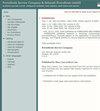Differential expression and regulation of CD6 on T-cell subsets revealed by monoclonal antibody (MAb) CH11.
引用次数: 3
Abstract
A monoclonal antibody (MAb), CH11, was developed by immunizing mice with CD4+ gammadelta T-cell receptor (TCR)+ cells. It recognized an antigen expressed in the surface membrane of T-cell lines, but not of U937, lymphoblastoid B cells (LBC), K562, Raji or Daudi cells, indicating selectivity for the T-cell lineage. In addition, it labelled 70-80% of normal peripheral blood mononuclear cells (PBMC), with high expression on the erythrocyte rosetting (E+) fraction, and low/absent expression on E- cells. However, CD4+ T cells expressed higher levels of reactivity than CD8+ or gammadelta+ T-cell receptor (TCR)+ lymphocytes in PB. Furthermore, in 7 of 10 individuals tested, 7.34+/-3.88% of unselected PBMC were CH11- CD3+ and were relatively enriched in CD8+ and in gammadelta TCR+-cells. In addition, thymic gammadelta T cells, and gammadelta lymphoproliferations from two patients were nonreactive or weakly reactive with the MAb. Activation of E+ cells with phorbol-12-myristate-13-acetate (PMA) enhanced CH11 expression uniformly, whereas activation with phytohemagglutinin (PHA) selectively down-regulated expression of the antigen on the CD8+ subset. In Western blots performed in nonreducing (NR) conditions, MAb CH11 detected a 100 kDa molecule in PBMC and Jurkat T-cell lysates. Preincubation of T cells with MAb CH11 specifically abrogated their subsequent reactivity with MAb to CD6, suggesting that MAb CH11 is recognizing an epitope of CD6. Given its function as a receptor for ligands on thymic epithelium, activated leukocytes and synoviocytes, this newly defined heterogeneity of expression and regulation of the CD6 molecule on subsets of T cells may help determine their functional repertoire in vivo.单克隆抗体(MAb) CH11揭示CD6在t细胞亚群上的差异表达和调控
通过免疫CD4+ γ - δ t细胞受体(TCR)+细胞制备单克隆抗体CH11。它识别t细胞系表面膜上表达的抗原,但不识别U937、淋巴母细胞样B细胞(LBC)、K562、Raji或Daudi细胞,表明对t细胞系有选择性。此外,它还标记了70-80%的正常外周血单个核细胞(PBMC),在红细胞形成(E+)部分高表达,在E-细胞上低表达或不表达。然而,CD4+ T细胞在PB中表达的反应性高于CD8+或γ - δ + T细胞受体(TCR)+淋巴细胞。此外,在10个被测试的个体中,有7个未选择的PBMC中有7.34+/-3.88%是CH11- CD3+,并且CD8+和γ - δ TCR+细胞相对丰富。此外,两名患者胸腺γ - T细胞和γ -淋巴细胞增生对单克隆抗体无反应或弱反应。用phorbel -12-肉豆蔻酸酯-13-乙酸酯(PMA)激活E+细胞可以均匀地增强CH11的表达,而用植物血凝素(PHA)激活则选择性地下调CD8+亚群上抗原的表达。在非还原(NR)条件下进行的Western blot中,MAb CH11在PBMC和Jurkat t细胞裂解物中检测到一个100 kDa的分子。用MAb CH11预孵育T细胞特异性地消除了随后与MAb对CD6的反应性,这表明MAb CH11识别CD6的表位。鉴于其作为胸腺上皮、活化的白细胞和滑膜细胞上配体受体的功能,这种新定义的CD6分子在T细胞亚群上的表达和调控异质性可能有助于确定它们在体内的功能库。
本文章由计算机程序翻译,如有差异,请以英文原文为准。
求助全文
约1分钟内获得全文
求助全文

 求助内容:
求助内容: 应助结果提醒方式:
应助结果提醒方式:


